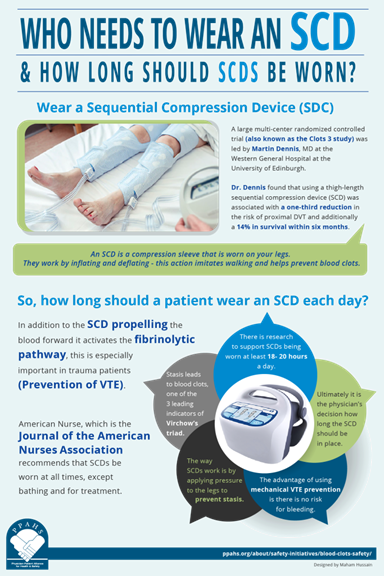Blood Clot Prevention: Who Needs to Wear an SCD and for How Long?
An Interview with Dr. Amy Campbell
By Michael Wong, JD
The CDC estimates that almost 1 million Americans suffer from venous thromboembolism (VTE), also known as blood clots. VTE is a term that is comprised of two medical conditions: deep vein thrombosis (DVT), which is a blood clot in one or more of the deep veins in the body (usually in the legs), and pulmonary embolism (PE), which is a blood clot in a pulmonary artery in the lungs.
According to the CDC:
- As many as 100,000 people die of blood clots each year
- PE is a leading cause of death in women during pregnancy or just after having a baby
- Blood clots are a leading cause of death in people with cancer after cancer itself
Amy Campbell, PhD, RN, CPHQ, LSBB, is a quality nurse specialist at Vidant Health in North Carolina. At Vidant Health, Dr. Campbell has drastically decreased the rate of VTE.
As blood clots are often preventable, I spoke with Dr. Campbell about what patients and their caregivers can do to prevent VTE.
VTE is a common occurrence in hospitalized patients. What is the most important thing I can do as a patient to help prevent getting a blood clot?
Amy Campbell: Hospitalized patients or any bedbound patients are at risk of getting a VTE. In addition to being over the age of 40 and being a smoker, we know that having one or more of the following conditions may also lead to VTE:
- Chronic lung disease
- Heart failure
- Serious infection
- Recovering from surgery
- Inflammatory bowel diseases
- Cancer
- Varicose veins
Any time a patient has limited physical activity, there is a risk of developing a VTE.
Previously, the thinking was to limit a patient’s activity to prevent a DVT from breaking loose and traveling to the lungs. However, research has shown that bed rest increases one’s VTE risk. Ambulation—just getting patients up, out of bed, and moving—should be considered for all DVT or PE patients.
In addition to ambulation, what else should patients and their caregivers consider?
AC: Wear a sequential compression device (SCD).
A large multi-center randomized controlled trial (also known as the CLOTS 3 study) was led by Martin Dennis, MD, at the Western General Hospital at the University of Edinburgh. Dr. Dennis found that using a thigh-length SCD was associated with a one-third reduction in the risk of proximal DVT and a 14% increase in survival within six months.
An SCD is a compression sleeve that is worn on your legs. They work by inflating and deflating; this action imitates walking and helps prevent blood clots.

How long should a patient wear an SCD each day?
AC: Research supports SCDs being worn at least 18 to 20 hours per day. Ultimately, the physician decides how long the SCD should be in place. The advantage of using mechanical VTE prevention is there is no risk of bleeding. The way SCDs work is by applying pressure to the legs to prevent stasis. Stasis leads to blood clots, one of the three leading indicators of Virchow’s triad. In addition to propelling the blood forward, the SCD activates the fibrinolytic pathway. This is especially important in trauma patients for prevention of VTE. American Nurse, the journal of the American Nurses Association, recommends that SCDs be worn at all times, except for bathing and for treatment.
Michael Wong, JD, is founder and executive director of the Physician-Patient Alliance for Health & Safety.
